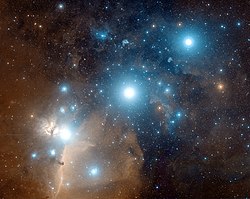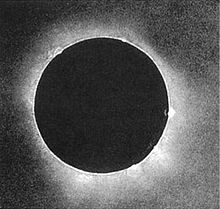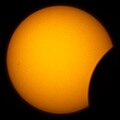An image of Orion's Belt
composited from digitized black-and-white photographic plates recorded
through red and blue astronomical filters, with a computer synthesized
green channel. The plates were taken using the Samuel Oschin Telescope between 1987 and 1991.
Astrophotography is a specialized type of photography for recording photos of astronomical objects, celestial events, and areas of the night sky. The first photograph of an astronomical object (the Moon) was taken in 1840, but it was not until the late 19th century that advances in technology allowed for detailed stellar photography. Besides being able to record the details of extended objects such as the Moon, Sun, and planets, astrophotography has the ability to image objects invisible to the human eye such as dim stars, nebulae, and galaxies. This is done by long time exposure since both film and digital cameras can accumulate and sum light photons over these long periods of time.
Photography revolutionized the field of professional astronomical research, with longtime exposures recording hundreds of thousands of new stars and nebulae that were invisible to the human eye, leading to specialized and ever larger optical telescopes that were essentially big cameras designed to record light using photographic plates. Astrophotography had an early role in sky surveys and star classification but over time it has given way to more sophisticated equipment and techniques designed for specific fields of scientific research, with image sensors becoming just one of many forms of sensor.
Today, astrophotography is mostly a subdiscipline in amateur astronomy, usually seeking aesthetically pleasing images rather than scientific data. Amateurs use a wide range of special equipment and techniques.
Overview
The large 48" Oschin Schmidt Camera at Palomar Observatory
With a few exceptions, astronomical photography employs long exposures since both film and digital imaging devices can accumulate and light photons over long periods of time. The amount of light hitting the film or detector is also increased by increasing the diameter of the primary optics (the objective) being used. Urban areas produce light pollution so equipment and observatories doing astronomical imaging are often located in remote locations to allow long exposures without the film or detectors being swamped with stray light.
Since the Earth is constantly rotating, telescopes and equipment are rotated in the opposite direction to follow the apparent motion of the stars overhead (called diurnal motion). This is accomplished by using either equatorial or computer-controlled altazimuth telescope mounts to keep celestial objects centered while the earth rotates. All telescope mount systems suffer from induced tracking errors due to imperfect motor drives, mechanical sag of the telescope and atmospheric refraction. Tracking errors are corrected by keeping a selected aiming point, usually a guide star, centered during the entire exposure. Sometimes (as in the case of comets) the object to be imaged is moving, so the telescope has to be kept constantly centered on that object. This guiding is done through a second co-mounted telescope called a "guide scope" or via some type of "off-axis guider", a device with a prism or optical beam splitter that allows the observer to view the same image in the telescope that is taking the picture. Guiding was formerly done manually throughout the exposure with an observer standing at (or riding inside) the telescope making corrections to keep a cross hair on the guide star. Since the advent of computer-controlled systems this is accomplished by an automated systems in professional and even amateur equipment.
Astronomical photography was one of the earliest types of scientific photography and almost from its inception it diversified into subdisciplines that each have a specific goal including star cartography, astrometry, stellar classification, photometry, spectroscopy, polarimetry, and the discovery of astronomical objects such as asteroids, meteors, comets, variable stars, novae, and even unknown planets. These often require specialized equipment such as telescopes designed for precise imaging, for wide field of view (such as Schmidt cameras), or for work at specific wavelengths of light. Astronomical CCD cameras may cool the sensor to reduce thermal noise and to allow the detector to record images in other spectra such as in infrared astronomy. Specialized filters are also used to record images in specific wavelengths.
History
Henry Draper with a refractor telescope set up for photography (photo probably taken in the 1860s or early 1870).[3]
The development of astrophotography as a scientific tool was pioneered in the mid-19th century for the most part by experimenters and amateur astronomers, or so-called "gentleman scientists" (although, as in other scientific fields, these were not always men). Because of the very long exposures needed to capture relatively faint astronomical objects, many technological problems had to be overcome. These included making telescopes rigid enough so they wouldn’t sag out of focus during the exposure, building clock drives that could rotate the telescope mount at a constant rate, and developing ways to accurately keep a telescope aimed at a fixed point over a long period of time. Early photographic processes also had limitations. The daguerreotype process was far too slow to record anything but the brightest objects, and the wet plate collodion process limited exposures to the time the plate could stay wet.
The first-known attempt at astronomical photography was by Louis Jacques Mandé Daguerre, inventor of the daguerreotype process which bears his name, who attempted in 1839 to photograph the Moon. Tracking errors in guiding the telescope during the long exposure meant the photograph came out as an indistinct fuzzy spot. John William Draper, New York University Professor of Chemistry, physician and scientific experimenter managed to make the first successful photograph of the moon a year later on March 23, 1840, taking a 20-minute-long daguerreotype image using a 5-inch (13 cm) reflecting telescope.
The Sun may have been first photographed in an 1845 daguerreotype by the French physicists Léon Foucault and Hippolyte Fizeau. A failed attempt to obtain a photograph of a Total Eclipse of the Sun was made by the Italian physicist, Gian Alessandro Majocchi during an eclipse of the Sun that took place in his home city of Milan, on July 8, 1842. He later gave an account of his attempt and the Daguerreotype photographs he obtained, in which he wrote
- "...a few minutes before and after totality an iodized plate was exposed in a camera to the light of the thin crescent, and a distinct image was obtained; but another plate exposed to the light of the corona for two minutes during totality did not show the slightest trace of photographic action. No photographic alteration was caused by the light of the corona condensed by a lens for two minutes, during totality, on a sheet of paper prepared with bromide of silver."
The first solar eclipse photograph taken on July 28, 1851 by a daguerrotypist named Berkowski.
The Sun's solar corona was first successfully imaged during the Solar eclipse of July 28, 1851. Dr. August Ludwig Busch, the Director of the Königsberg Observatory gave instructions for a local daguerreotypist named Johann Julius Friedrich Berkowski to image the eclipse. Busch himself was not present at Königsberg (now Kaliningrad, Russia), but preferred to observe the eclipse from nearby Rixhoft. The telescope used by Berkowski was attached to 6 1⁄2-inch (17 cm) Königsberg heliometer and had an aperture of only 2.4 in (6.1 cm), and a focal length of 32 in (81 cm). Commencing immediately after the beginning of totality, Berkowski exposed a daguerreotype plate for 84 seconds in the focus of the telescope, and on development an image of the corona was obtained. He also exposed a second plate for about 40 to 45 seconds but was spoiled when the sun broke out from behind the moon. More detailed photographic studies of the Sun were made by the British astronomer Warren De la Rue starting in 1861.
The first photograph of a star was a daguerreotype of the star Vega by astronomer William Cranch Bond and daguerreotype photographer and experimenter John Adams Whipple, on July 16 and 17, 1850 with Harvard College Observatory's 15 inch Great refractor. In 1863 the English chemist William Allen Miller and English amateur astronomer Sir William Huggins used the wet collodion plate process to obtain the first ever photographic spectrogram of a star, Sirius and Capella. In 1872 American physician Henry Draper, the son of John William Draper, recorded the first spectrogram of a star (Vega) to show absorption lines.
Henry Draper's 1880 photograph of the Orion Nebula, the first ever taken.
One
of Andrew Ainslie Common's 1883 photographs of the same nebula, the
first to show that a long exposure could record stars and nebulae
invisible to the human eye.
The first all-sky photographic astrometry project, Astrographic Catalogue and Carte du Ciel, was started in 1887. It was conducted by 20 observatories all using special photographic telescopes with a uniform design called normal astrographs, all with an aperture of around 13 in (330 mm) and a focal length of 11 ft (3.4 m), designed to create images with a uniform scale on the photographic plate of approximately 60 arcsecs/mm while covering a 2° × 2° field of view. The attempt was to accurately map the sky down to the 14th magnitude but it was never completed.
The beginning of the 20th century saw the worldwide construction of refracting telescopes and sophisticated large reflecting telescopes specifically designed for photographic imaging. Towards the middle of the century, giant telescopes such as the 200 in (5.1 m) Hale Telescope and the 48 in (120 cm) Samuel Oschin telescope at Palomar Observatory were pushing the limits of film photography.
Some progress was made in the field of photographic emulsions and in the techniques of forming gas hypersensitization, cryogenic cooling, and light amplification, but starting in the 1970s after the invention of the CCD, photographic plates were gradually replaced by electronic imaging in professional and amateur observatories. CCD's are far more light sensitive, do not drop off in sensitivity over long exposures the way film does ("reciprocity failure"), have the ability to record in a much wider spectral range, and simplify storage of information. Telescopes now use many configurations of CCD sensors including linear arrays and large mosaics of CCD elements equivalent to 100 million pixels, designed to cover the focal plane of telescopes that formerly used 10–14-inch (25–36 cm) photographic plates.
The late 20th century saw advances in astronomical imaging take place in the form of new hardware, with the construction of giant multi-mirror and segmented mirror telescopes. It would also see the introduction of space based telescopes, such as the Hubble Space Telescope. Operating outside the atmosphere’s turbulence, scattered ambient light and the vagaries of weather allows the Hubble Space Telescope, with a mirror diameter of 2.4 metres (94 in), to record stars down to the 30th magnitude, some 100 times dimmer than what the 5-meter Mount Palomar Hale telescope could record in 1949.
Amateur astrophotography
2
minute time exposure of the comet Hale-Bopp imaged using a camera on a
fixed tripod. The tree in the foreground was illuminated using a small
flashlight.
Astrophotography is a popular hobby among photographers and amateur astronomers. Images of the night sky can be obtained with the most basic film and digital cameras. For simple star trails, no additional equipment may be necessary other than common tripods. There is a wide range of commercial equipment geared toward basic and advanced astrophotography. Amateur astronomers and amateur telescope makers also use homemade equipment and modified devices.
Media
Images are recorded on many types of media and imaging devices including single-lens reflex cameras, 35 mm film, digital single-lens reflex cameras, simple amateur-level and professional-level commercially manufactured astronomical CCD cameras, video cameras, and even off-the-shelf webcams adapted for long-exposure imaging.Conventional over-the-counter film has long been used for astrophotography. Film exposures range from seconds to over an hour. Commercially available color film stock is subject to reciprocal failure over long exposures, in which sensitivity to light of different wavelengths appears to drop off at different rates as the exposure time increases, leading to a color shift in the image. This is compensated for by using the same technique used in professional astronomy of taking photographs at different wavelengths that are then combined to create a correct color image. Since film is much slower than digital sensors, tiny errors in tracking can be corrected without much noticeable effect on the final image. Film astrophotography is becoming less popular due to the lower ongoing costs, greater sensitivity and the convenience of digital photography.
Video of night sky made with DSLR camera's time-lapse feature. Photographer added camera movement (motion control) making the camera track in a random direction off the normal equatorial axis.
Post-processing
The
Pleiades Star Cluster photographed with a 6 megapixel digital SLR
camera connected to a 80mm refracting telescope piggybacked on a larger
telescope. Image is made from seven 180 second images combined and
processed in Photoshop with a noise reduction plugin.
Hardware
Astrophotographic hardware among non-professional astronomers varies widely, since the photographers themselves range from general photographers shooting some form of aesthetically pleasing images to very serious amateur astronomers collecting data for scientific research. As a hobby, astrophotography has many challenges that have to be overcome that differ from conventional photography and from what is normally encountered in professional astronomy.
NGC281, popularly the 'Pacman Nebula', imaged from a suburban location using a 130mm amateur telescope and a DSLR camera.
Some camera manufacturers modify their products to be used as astrophotography cameras, such as Canon's EOS 60Da, based on the EOS 60D but with a modified infrared filter and a low-noise sensor with heightened hydrogen-alpha sensitivity for improved capture of red hydrogen emission nebulae.
There are also cameras specifically designed for amateur astrophotography based on commercially available imaging sensors. They may also allow the sensor to be cooled to reduce image noise in long exposures, provide raw image readout and to be controlled from a computer for automated imaging. Raw image readout allows later better image processing by retaining all the original image data which along with stacking can assist in imaging faint deep sky objects.
With very low light capability, a few specific models of webcams are popular for Solar, Lunar and Planetary imaging. Mostly, these are manually focused cameras containing a CCD sensor instead of the more common CMOS. The lenses of these cameras are removed and then these are attached to telescopes to record images, video or both. In newer techniques, videos of very faint objects are taken and the sharpest frames of the video are 'stacked' together to obtain a still image of respectable contrast. The Philips PCVC 740K and SPC 900 are among the few webcams liked by astrophotographers.
Equipment setups
An amateur astrophotography setup with an automated guide system connected to a laptop.
- Fixed or tripod
- Tracking mounts
- "Piggyback" photography
- Telescope focal plane photography
- Prime focus – In this method the image produced by the telescope falls directly on the film or CCD with no intervening optics or telescope eyepiece.
- Positive projection – A method in which the telescope eyepiece (eyepiece projection) or a positive lens (placed after the focal plane of the telescope objective) is used to project a much more magnified image directly onto the film or CCD. Since the image is magnified with a narrow field of view this method is generally used for lunar and planetary photography.
- Negative projection – This method, like positive projection, produces a magnified image. A negative lens, usually a Barlow or a photographic teleconverter, is placed in the light cone before the focal plane of the telescope objective.
- Compression – Compression uses a positive lens (also called a focal reducer), placed in the converging cone of light before the focal plane of the telescope objective, to reduce overall image magnification. It is used on very long focal length telescopes, such as Maksutovs and Schmidt–Cassegrains, to obtain a wider field of view.
Remote Telescope Astrophotography
With the development of fast Internet in the last part of the 20th century along with advances in computer-controlled telescope mounts and CCD cameras 'Remote Telescope' astronomy is now a viable means for amateur astronomers not aligned with major telescope facilities to partake in research and deep sky imaging. This enables the imager to control a telescope a large distance away in a dark location. The observers can image through the telescopes using CCD cameras. Imaging can be done regardless of the location of the user or the telescopes they wish to use. The digital data collected by the telescope is then transmitted and displayed to the user by means of the Internet. An example of a digital remote telescope operation for public use via the Internet is The Bareket Observatory.Examples of amateur astrophotography techniques
- Fixed tripod mounted camera capturing "star trails"
- Fixed tripod image of a solar eclipse using a digital-SLR camera with a 500 mm lens
- Comet Hale-Bopp, camera with a 300mm lens piggybacked
- Image of the moon taken with a Nikon Coolpix P5000 digital camera via Afocal projection through an 8-inch Schmidt–Cassegrain telescope
- The Moon photographed using the Afocal technique, using 10 seconds of video stacked to create a final image.
- A composite of several Digital-SLR photos compiled in Photoshop taken via eyepiece projection from an 8-inch Schmidt Cassegrain telescope.
- Saturn image using negative projection (Barlow lens) with a webcam attached to a 250mm Newtonian telescope. It is a composite images made from 10% of the best exposures out of 1200 images using freeware image stacking and sharpening software (Giotto)
























